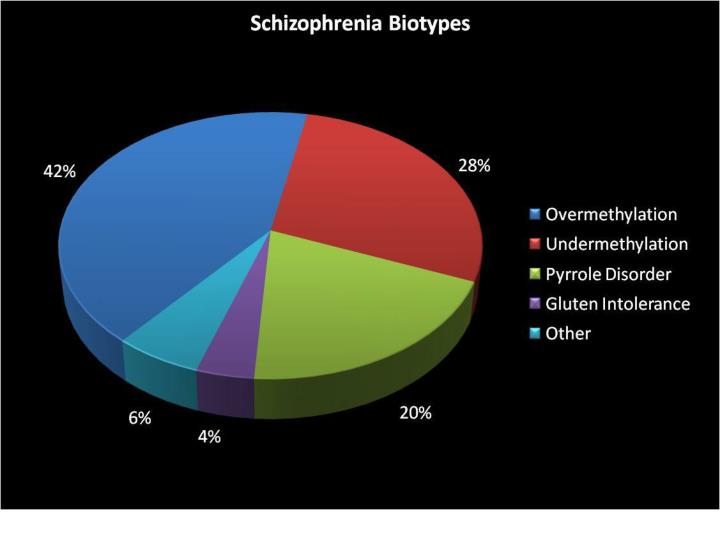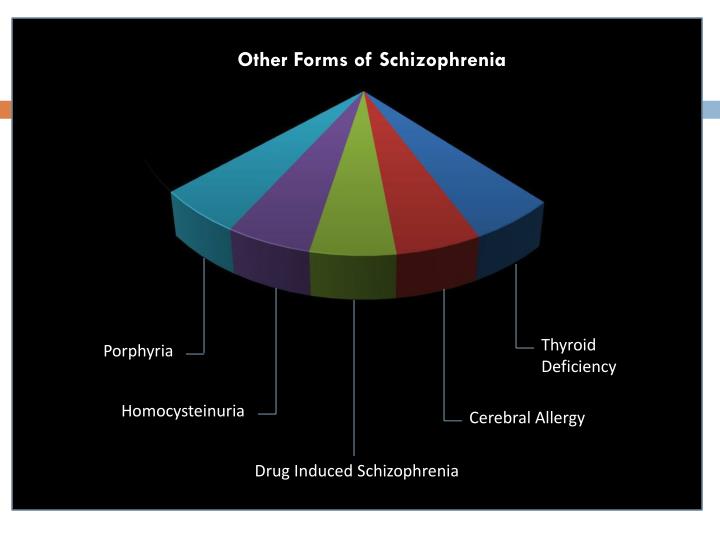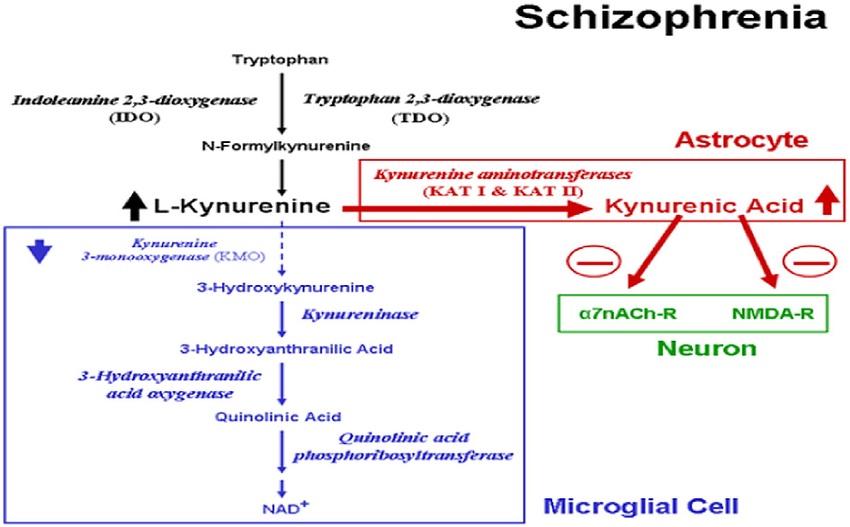Schizophrenia
Schizophrenia: Biotypes
*NOTE: The biotypes listed do not fall within the strict limits of the disorders or conditions described. Those with pyroluria, high histamine, or low histamine, do not necessarily need to exhibit schizophrenia. The major biotypes associated with schizophrenia occur in the general population, but to a more limited extent. It is particularly likely that some family members will have the same biotype as the relative diagnosed as schizophrenic. These similar biochemical backgrounds can manifest differently. Mental traits may vary from eccentricity, rigidity, compulsiveness, or a preference for seclusion, to full-blown psychosis.
Histamine Imbalances:
In 1966, Carl Pfieffer and colleagues at the New Jersey Neuro-Psychiatric Institute discovered that average blood histamine levels for 72 chronic male schizophrenics were much lower than normal, and when histamine levels were increased, dysperception test scores improved.
Later, it was discovered that a group of outpatients with elevated histamine, whose symptoms improved as histamine levels were reduced.
Pfieffer found that patients with histamine imbalances comprised almost 2/3rds of schizohprenics.
HISTAPENIA: Low Histamine
-present in 40-50% of schizophrenics. Characterized by low levels of blood histamine and folate, and overmethylation. Dopamine and norepinephrine are typically elevated.
Symptoms include anxiety and depression, and, if metal metabolism is also imbalanced, thought disorder, paranoia, hallucinations, and other classic symptoms of schizophrenia. Histapenia may also play a role in hyperactivity, learning disorders, and panic disorder
Causes of Histapenia: -Major factors include:
-over-methylation
-low folate
-excess copper
Physical Symptoms and Tendencies
-high pain and shock threshold
-headaches, colds, respiratory allergies are uncommon, but often very allergic to foods and can have severe chemical sensitivities
-prone to upper body pain(shoulder, upper back, brain, head, neck, face)
-Slow metabolism. Easily fatigued or frustrated.
-Stuttering
-Ringing in the ears
-Poor dental health, due to lack of secretions in the mouth.
-Difficulty reaching orgasm. Low libido
-Estrogen sensitivity.
-Tendency to rhematoid arthritis, Parkinsonian tremors, obsessional or hyperkinetic movement.
Appearance
-young looking.
-plentiful body hair
-tend towards weight gain
-teeth are often in poor shape.
Typical Mental Symptoms
-Anxiety, panic attacks
-Hyperactivity
-Hypomania
-Grandiosity
-Insomnia
-Thought disorder. Ideation is difficult. Ideas of reence.
-Hallucinations, voices, evil spirits
-Paranoia, delusions of persecution, suspiciousness.
-Withdrawal from reality
-Severe dysperceptions of time, body, self, others.
Laboratory tests
Histamine determinations
-basophil count: blood basophils and mast cells are the main storage sites for histamin e outside the nervous system.
e outside the nervous system.
-whole blood histamine.
Additional Tests
-Hair and serum copper-usually test high. Elevated copper suggests metallothionein dysfunction.
-Heavy metal sensitivity is common.
For further information call 07 32045877.
References.
Kynurenic acid and schizophrenia.
The kynurenic acid hypothesis of schizophrenia
grantome.com/grant/NIH/P50-MH103222-04-6264
https://pdfs.semanticscholar.org/cea5/f2b9894cdd9a8e317840bd441419d50b1d75.pdf
www.jneurosci.org/content/jneuro/34/32/10592.full.pdf
www.biologicalpsychiatryjournal.com/article/S0006-3223(17)30916-2/pdf
pubmedcentralcanada.ca/pmcc/articles/PMC4219570/
https://springerplus.springeropen.com/articles/10.1186/s40064-015-0826-9
onlinelibrary.wiley.com/doi/10.1111/j.1601-5215.2006.00170.x/abstract
www.psy-journal.com/article/S0165-1781(12)00453-2/fulltext
faculty.psy.ohio-state.edu/bruno/documents/AlexanderacuteKYNsetshift2012.pdf
www.ajpb.com/news/metabolite-may-effectively-treat-schizophrenia
https://www.ncbi.nlm.nih.gov/pmc/articles/PMC4179604
https://www.ncbi.nlm.nih.gov/pubmed/24091034
www.schres-journal.com/article/S0920-9964(97)88530-1/abstract
https://neuroshaman.wordpress.com/2016/01/23/kynurenic-acid-a-factor-for-schizophrenia-and-autism/.
researchonline.jcu.edu.au/20733/1/20733.pdf
https://jneuroinflammation.biomedcentral.com/articles/10.1186/1742-2094-10-43
https://researchers.mq.edu.au/en/publications/quinolinic-acid-neurotoxicity
https://www.ncbi.nlm.nih.gov/pmc/articles/PMC3082825/
https://www.ncbi.nlm.nih.gov/pmc/articles/PMC4612505/
https://www.ncbi.nlm.nih.gov/pubmed/22814706
www.ajgponline.org/article/S1064-7481(16)30264-0/abstract
www.sciencedirect.com/science/article/pii/S092493381376423X
journals.sagepub.com/doi/abs/10.1177/0269881112467089
https://www.jscimedcentral.com/Schizophrenia/schizophrenia-1-1001.pdf
https://www.nsf.no/Content/2638925/cache=20163004101523/Ingrid%20Dieset.pdf
https://www.ncbi.nlm.nih.gov/pubmed/15319094
https://www.ncbi.nlm.nih.gov/pmc/articles/PMC3408569/
medind.nic.in/daa/t08/i2/daat08i2p190.pdf
https://www.hindawi.com/journals/jpath/2011/128318/
https://www.ncbi.nlm.nih.gov/pmc/articles/PMC4437570/
https://www.ncbi.nlm.nih.gov/pmc/articles/PMC2774708/
